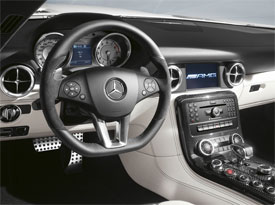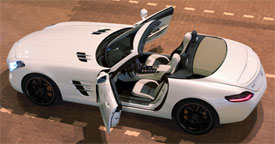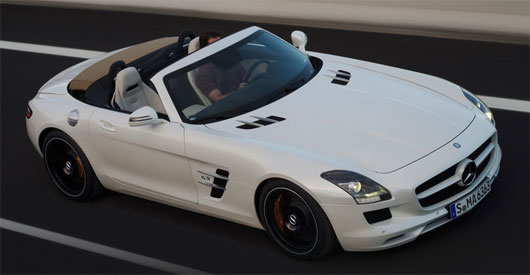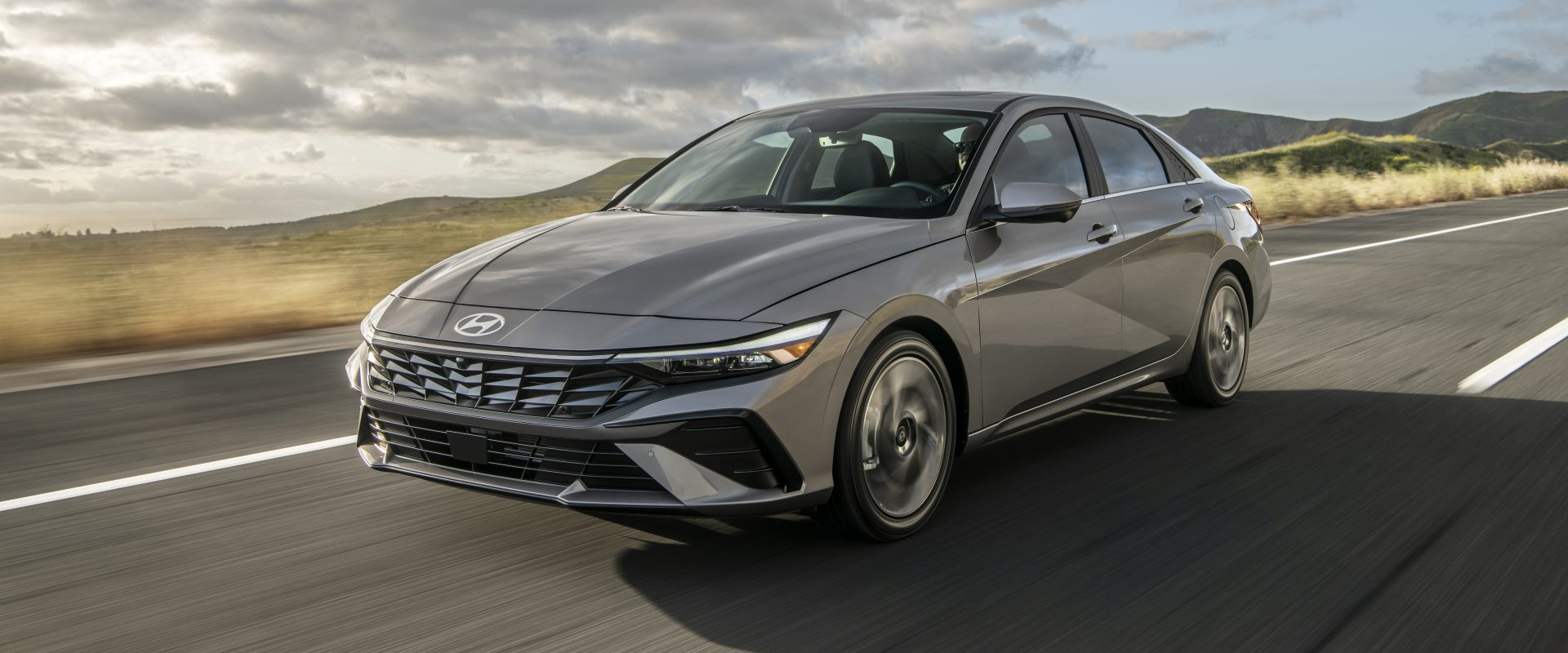2012 Mercedes-Benz SLS AMG Roadster
The SLS was the first car totally designed by Mercedes-Benz’ AMG performance brand. And it sure impressed us, not only with its sheer performance, but by successfully pulling off the gullwing-coupe styling of the original SL. And we knew it was just a matter of time before this car arrived, the SLS AMG Roadster. Now it trades the gullwing doors for a folding soft top; so, let’s see if that was a good trade or a bad one.
Well in any transaction, there are usually winners and losers. Oftentimes when a hard top is traded for a soft one, the loser is body rigidity and handling. The fact that the 2012 Mercedes Benz SLS AMG Roadster rides on the same rigid aluminum space-frame as the SLS Coupe certainly helps to alleviate those concerns.
But, not wanting to leave anything to chance, AMG added thicker door sill members, inserted bracing into the dashboard cross member, windshield frame, and center tunnel as well as bolted structural reinforcements to the soft top storage compartment and rear axle mounts. They also added an additional cross-member behind the rear seats for the dual roll bars. While it doesn’t have quite the same stunning look as the Coupe, the Roadster does exude the same classy aggressiveness typical of a sporting Mercedes.
The top is triple layer fabric, with glass rear window and folds in just 11-seconds, blending in very nicely with the overall design. Trunk space remains the same whether the top is up or down, and holds just slightly less than the Coupe at 6.1 cubic-feet. Rolling stock is 265/35/19’s up front and 295/30/20’s in the rear, on “flow-formed” lightweight alloy wheels.
While the looks certainly aim to please, under the SLS Roadster’s long hood lies an engine that’s even more eager to please. It’s the same naturally aspirated 6.2-liter AMG-designed power unit as the Coupe; that revs to 7,200 RPM, producing 563-horsepower and 479 pound-feet of torque along the way.
 While we loved the classic red leather interior in our last Coupe, most of the staff loved our test Roadster’s heritage white leather and black stitching theme even more. There is a roomier feel to the open air seating, and the seats themselves are comfortable and supportive. As before, most controls are angled towards the driver and easy to reach. Red needle gauges on silver backgrounds have an aviation look to them. And they are easy to read at track speeds which we easily exploited at our winter testing facility, Roebling Road Raceway near Savannah, Georgia.
While we loved the classic red leather interior in our last Coupe, most of the staff loved our test Roadster’s heritage white leather and black stitching theme even more. There is a roomier feel to the open air seating, and the seats themselves are comfortable and supportive. As before, most controls are angled towards the driver and easy to reach. Red needle gauges on silver backgrounds have an aviation look to them. And they are easy to read at track speeds which we easily exploited at our winter testing facility, Roebling Road Raceway near Savannah, Georgia.
Off the line, sprints to 60 were accomplished in just 3.6-seconds. That’s actually 3-tenths faster than we achieved in the Coupe last year, but track conditions were much more favorable this year. The ¼ mile was also a bit quicker at 11.8-seconds and 120 miles-per-hour. Best times were achieved by putting the AMG Speedshift DCT in Sport-plus mode and letting it rip through the gears on its own. When it came time for ripping through the corners, the SLS Roadster loses nothing to the Coupe. Weight is up only 88-pounds, and we noticed no lack of stiffness without the presence of a hard top.
The car still takes a bit of getting used to, due to the fact that you feel so far removed from the front wheels. But, as confidence builds, the SLS rewards aggressive driving with quick steering, good feedback, and smooth weight transitions. All-aluminum, double wishbone suspensions at both ends keep things relatively flat in corners. While the optional 3-mode adaptive suspension does even better.
Although it lacked the optional AMG ceramic braking system, our car’s brakes worked great throughout our testing, offering good feel and fade free work. Straight line stops averaged a good 121-feet, and that was after a couple days of abuse.
On public roads, at more sane speeds, the SLS is no less rewarding. There are no supercar quirks to deal with, just a comfortable, almost daily-driver-like nature. Top down cruising is more in the old school Roadster vein, with lots of wind in your hair as you appreciate the stirring sound of that big V8.
Government Fuel Economy Ratings for the Roadster are the same as the Coupe, 14-City, 20-Highway. Expect to average around 16 miles per gallon of Premium in daily use.
 Since we picked the SLS as one of our Drivers’ Choice Dream Machines, supercar pricing is expected. The SLS Roadster rings up about $7,000 more than the gullwing Coupe at $196,975.
Since we picked the SLS as one of our Drivers’ Choice Dream Machines, supercar pricing is expected. The SLS Roadster rings up about $7,000 more than the gullwing Coupe at $196,975.
Life is full of tough decisions. The 2012 SLS AMG Roadster is indeed a throwback, but one that also throws you back in your seat. It may have traded its gullwing doors for a folding soft top, but it lost nothing in the performance category during the exchange. So, now there is a choice; cool gull wing doors that everyone can see you get in and out of, or an open air cockpit where everyone can see you cruising around in. Whichever one you spend your lottery dollars on you’ll be a real winner.
Specifications
- Engine: 6.2-liter
- Horsepower: 563
- Torque: 479 lb-ft.
- 0-60 mph: 3.6 seconds
- 1/4 mile: 11.8 seconds @120 mph
- EPA: 14 mpg city/20 mpg highway
2024 Hyundai Elantra
Basic Transportation At Its Best…And That Is A Compliment
For those of you who write in every week bemoaning the fact that all we seem to do around here is test incredibly expensive cars and EVs that only the very well to do can afford, this one’s for you. It’s a commuter and budget friendly mainstay from Hyundai, the compact Elantra sedan. And, it has been nicely updated for 2024.
We clearly do enjoy driving high-performance machines and ultra-luxury rides around here, but like most of you, when it comes time to drive home at the end of a long workday, we do so in something much more practical and affordable, like this 2024 Hyundai Elantra sedan.
If you’re thinking the front end has gotten more aggressive, you’re right. Hyundai calls it a “Shark Nose” theme, and we’re guessing they were thinking more Great White than Hammerhead, though Megamouth shark would also apply. It helps for a low and wide look; more substantial than the typical compact. Other additions for ’24 include slimmer daytime running lights, revised stainless steel Hyundai emblem, reshaped front fenders, sport sedan-style rear diffuser with silver trim; a parametric pattern added to the C-Pillar, and new LED taillights that take up a lot more space on the highly sculpted decklid. Plus, new wheel designs in sizes ranging from 15- to 18-inches.
Standard engine in SE, SEL, and Limited grades is this naturally aspirated 2.0-liter I4 with 147 horsepower and 132 lb-ft of torque. Even with no hybrid assistance, it gets substantial Government Fuel Economy Ratings of 31 City, 40 Highway, and 34 Combined; we averaged a great 38.6 mpg of Regular.
Those high fuel economy numbers mean acceleration times are pretty high as well. It was in no particular hurry to get off the line at our test track, as after a slight jolt of power, it felt pretty sluggish going down the track, taking us a lengthy 9.4 seconds to hit 60 mph. Hyundai’s Intelligent Variable Transmission has some realistic simulated gear shifts built in, and they not only provided the feel of a true automatic, but kept engine noise from becoming overbearing. And while this 2.0-liter may not be a house-on-fire off the line, it has no problem keeping up with traffic, and feels like just the perfect amount of power for a practical and safe commuter car.
There are other engine options too. Two choices if you want to go faster, a 1.6-liter turbo with 201 horsepower in the Elantra N Line, and a 276-horsepower turbocharged 2.0-liter for the Elantra N; plus, one with even better fuel economy, a 1.6-liter hybrid with a 139 horsepower total output.
And despite some significant understeer, there was good feel through the cones of our handling course, both in steering and chassis feedback. We wouldn’t quite call it “point and shoot,” but it responded to inputs fairly quickly, with only moderate body roll. All-in-all, when it comes to performance, it doesn’t claim to bring a whole lot to the table, but does clearly overachieve with what it does bring.
And Hyundai is always overachieving when it comes to packing in features, yet has found a way of keeping things refreshingly simple with a good mix of touchscreen and manual controls. Lots of space too, both up front in the surprisingly wide front buckets, and in the rear bench with ample room for three. Updates for all Elantra interiors include softer materials on the door panels, upgraded instrumentation and additional charging ports, plus a surround view monitor and new H-Tex simulated leather for Limited trim.
Elantra pricing starts with an SE at $22,775, the SEL comes in at $24,725, Limited begins at $28,215, and the sporty N Line starts at $29,615. If you’re interested in the hybrid, base Blue starts at $27,400 with Limited at $30,600.
Some might say there’s not a whole lot that’s earth shaking about the 2024 Hyundai Elantra, but that’s mostly why we like it so much. When it comes to just delivering good, basic transportation with a high dose of unexpected amenities, Hyundai delivers once again.
Specifications
- Engine: 2.0-liter I4
- Horsepower: 147
- 0-60 mph: 9.4 seconds
- 60-0 Braking: 111 ft (avg)
- MW Fuel Economy: 38.6 MPG (Regular)
- Transmission: IVT
- Torque: 132 lb-ft
- 1/4 Mile: N/A (Track Maintenance)
- EPA: 31 City / 40 Highway / 34 Combined







